Key Insights
- The circulating market cap of FTM increased 140% QoQ to $1.3 billion. FTM outperformed the total market cap of all cryptocurrencies in Q4.
- Revenue was up 63% YoY due to the emergence of Fantom Inscription FRC-20s in Q4. Daily revenue hit an all-time high on November 23, 2023.
- The Fantom Sonic builders testnet launched in December. It allows developers to create smart contracts on the testnet to try out Fantom Sonic’s increased capabilities.
- DeFi TVL increased 58% QoQ to $81 million. The increase was attributed to both FTM price increases and the gaining popularity of newer dApps like Equalizer Exchange and WigoSwap.
- The first distribution of the Ecosystem Vault occurred in October, totaling 750,000 FTM distributed to 12 different projects.
Primer
Fantom (FTM), launched in 2018, is a Layer-1 protocol focused on fast and cost-efficient transaction execution. Fantom became a DeFi hub with development help from Andre Cronje. As a result, Fantom’s network hosts dozens of DeFi protocols, including Equalizer Finance, Beethoven X, and SpookySwap. In addition to DeFi, Fantom also supports NFTs and games, like the new Estfor Kingdom.
Fantom uses a Proof-of-Stake consensus mechanism called “Lachesis”, which was created by the Fantom Foundation. Lachesis provides security to the Fantom Opera Chain, which is an EVM-compatible smart contract chain. Because Fantom nodes reach consensus independently, each node verifies transactions asynchronously and is not required to incorporate other blocks sequentially. This speeds up transaction execution.
FTM, the project’s native token, is used for payments and governance. It also enables ongoing block rewards for validators and delegators who stake FTM. Fantom validators must stake a minimum of 50,000 FTM. For a full primer on Fantom, refer to our Initiation of Coverage report.
Website / X (Twitter) / Discord
Key Metrics
Financial Overview
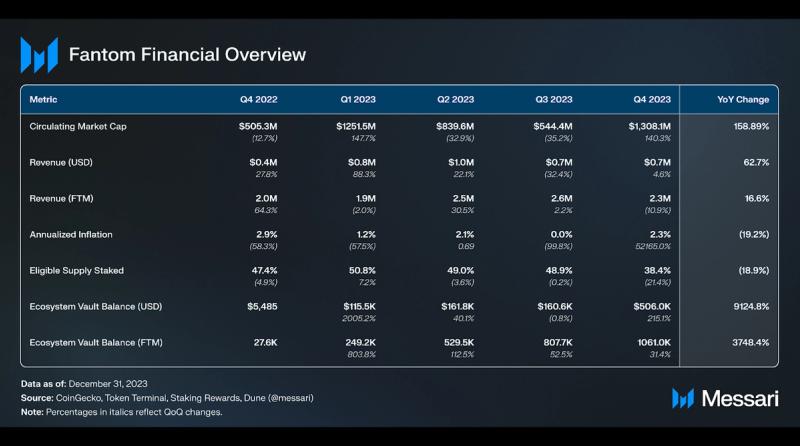
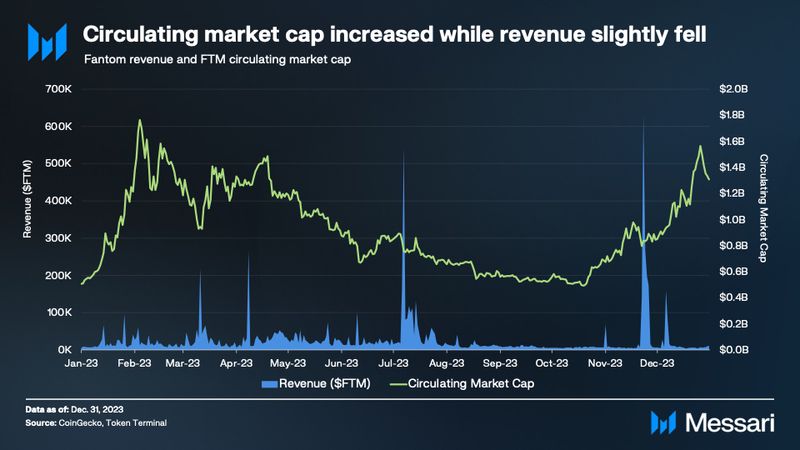
Q4’23 featured a resurgent crypto market with the possibility of a Bitcoin ETF approval. FTM was no exception, as its circulating market cap increased 140% QoQ from $0.5 billion to $1.3 billion. Additionally, FTM outperformed the total market cap of all cryptocurrencies, which gained 54% in Q4. By the end of the quarter, FTM’s market cap rank among all tokens rose by 5 spots from 63 to 58.
Revenue finished strong during the second half of Q4. Similar to many other Layer-1 networks, Fantom saw a big spike in revenues due to inscriptions — specifically, Fantom Inscription FRC-20s inscriptions. Also known as “fans,” these inscriptions are calldata sent in a transaction. Although this calldata is entirely onchain, offchain indexers actually interpret the calldata and determine what it is doing. One such indexer, FRC20 Market, for Fantom can be found here.
These inscriptions began to emerge on Fantom during November. From November 22-26, Fantom netted $421,000 in revenue from fees, mostly attributed to inscriptions. In fact, November 23 was the highest day of revenue ($187,000) for Fantom during all of 2023. This time period alone represented over 50% of Fantom’s revenues for the entire quarter. Quarterly revenue in USD ended up increasing slightly QoQ from $673,000 to $704,000. Part of this increase can be attributed to the price appreciation of FTM, as revenues in FTM fell 11% in Q4.
The circulating supply of FTM was essentially flat QoQ after supply dynamics changed between Q4’22 and Q1’23. During Q4’23, Fantom’s Ecosystem Vault and Gas Monetization program were introduced (more details in the Ecosystem section). They reduced the burn rate of transaction fees from 30% to 5%, with the remaining 25% reallocated to the Gas Monetization program and Ecosystem Vault. At the same time, validator rewards remained constant. They were last changed in Q1’23, when Proposal 23 was passed, reducing inflationary validator rewards from 14% to 6%. As such, inflationary staking rewards are projected to last until 2028. Additionally, by December 31, 2023, over 11.1 million FTM (0.3% of its 3.175 billion supply) was burned.
Lastly, the staking ratio (the proportion of Fantom’s total supply actively being staked) decreased 21% QoQ to 38%. Eligible supply stake has since increased to 45% as of January 3, 2024, likely signaling that the Q4 drop was due to stake switching validators, rather than exiting.
Network Overview
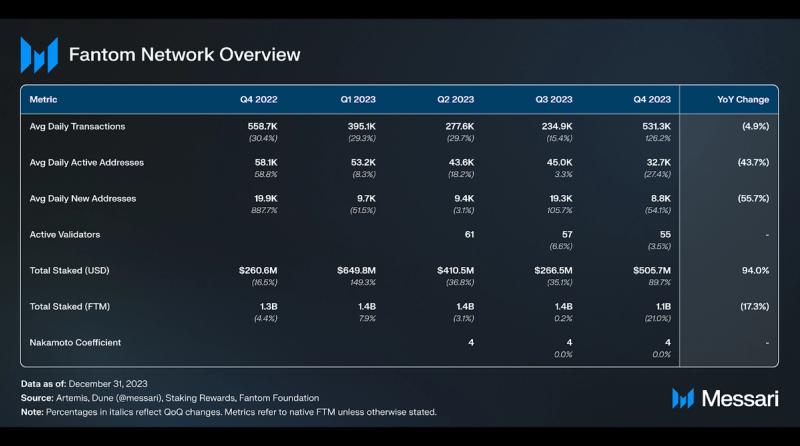
Usage
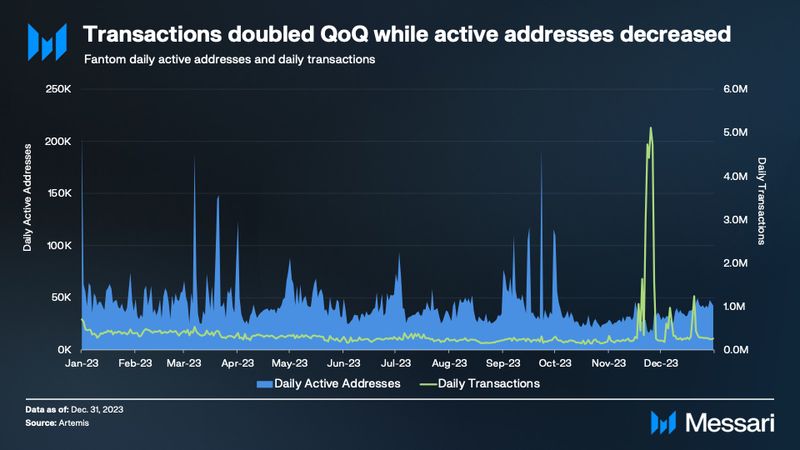
In Q4’23, Fantom had an average of 32,700 daily active addresses, down 27% QoQ. Although this decrease was below the long-term yearly average of 48,000, the number of daily active addresses began to increase steadily during the month of December (up 29% MoM), perhaps signaling future increases as crypto exits its bear market.
As for average daily transactions, Fantom reversed its declining trend in Q4’23, up 126% to 531,000. This reversal was largely due to the emergence of the aforementioned Fantom Inscription FRC20s. Fantom reached an all-time high for daily transactions on November 25. This all-time high of 5.11 million transactions eclipsed the previous one (September 11, 2021 – 1.73 million) by nearly 3 times. Of these 5.11 million transactions, 4.99 million were inscriptions. Fantom also saw a smaller increase in transactions during the first week of December. Notably, this increase was also likely caused by inscriptions. From December 4-7, there were 2.74 million transactions.
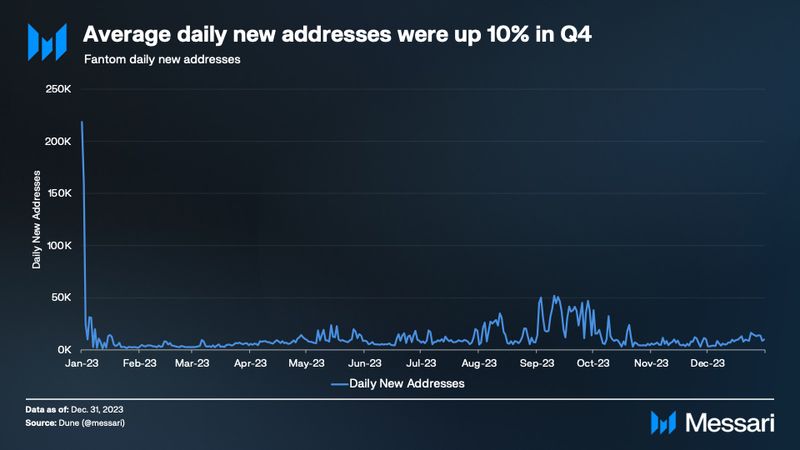
Daily new addresses increased again in Q4’23, up 10% to 21,100. The month with the biggest increase was October. The increase in daily new addresses coincides with the late-August launch of Estfor Kingdom, a blockchain-based game on Fantom that gained popularity at the end of Q3’23. According to DappRadar, Estfor Kingdom averaged 5,100 daily active users from October 1-7. Over that same time period, there was an average of 16,200 new addresses per day on Fantom. Additionally, December saw increases in daily new addresses, likely due to the return of favorable market conditions.

Despite the increase in transactions from inscriptions, average daily gas fees did not eclipse any previous all-time highs. Gas fees did however spike during the periods of November 22-26 and December 4-7, which saw large increases in inscriptions. The highest daily average gas price occurred on November 23, 2023, when gas nearly hit 5,500 Gwei. Other than the inscription-related spikes, gas prices remained at historical averages during Q4.
Security and Decentralization
Fantom uses a Proof-of-Stake consensus mechanism called Lachesis. It is the consensus and security mechanism for Fantom’s EVM-compatible smart contract chain, Opera.
Fantom nodes reach consensus independently. Because each node verifies transactions asynchronously and is not required to incorporate other blocks sequentially, Fantom’s consensus mechanism speeds up transaction execution. Fantom validators earn rewards that are a combination of the following:
- Staking Rewards – At genesis, 1.04 billion native FTM (32.75% of the maximum token supply) was allocated to staking rewards. The validator reward rate was set to 6% by governance. The amount of staking rewards each validator receives depends on the amount of FTM staked/delegated to it and its uptime.
- Block Rewards – All transaction fees from blocks, paid in native FTM, accumulate to the Fantom SFC smart contract. Of these transaction fees, 70% of the FTM is distributed to validators.
As of Q4’23, the state of Fantom’s security and decentralization consisted of the following:
- Active validators – 55 (down 4% QoQ)
- Total staked (in FTM) – 1.1 billion (down 21% QoQ)
- Nakamoto coefficient – 4 (flat QoQ)
In order to take over the network through a two-thirds attack, a malicious actor would need to control 933 million FTM ($183 million), as of quarter end.
Fantom Sonic
One of Fantom’s biggest initiatives in Q4’23 was the Fantom Sonic upgrade. Fantom Sonic aims to improve the scalability of the network through two new implementations.
The first is the Fantom Virtual Machine (FVM). The FVM is similar to Fantom’s current EVM-compatible engine, as both are compatible with Solidity and Vyper. However, the FVM also offers improvements that should increase Fantom’s execution speed. The FVM uses dynamic translation, which allows code related to smart contracts to be translated into a more efficient instruction format. Dynamic translation also enables multiple instructions to be merged into one “super-instruction,” decreasing the number of executions needed.
The second change is a new storage system for Fantom. The new storage system seeks to decrease access times through a file-based StateDB. A file-based StateDB makes managing and updating state information more efficient. It uses several functions, such as removing the need to map data to key/value stores, not using RLP encoding, and not actively pruning Merkle Patricia Trie (MPT). For validator nodes, it has the potential to reduce storage requirements by over 90%. According to Andre Cronje, these storage requirements are small enough that a validator node can be run on a Raspberry Pi.
Additionally, Fantom Sonic includes optimization and fine-tuning improvements to the Lachesis consensus mechanism.
Ultimately, Fantom Sonic aims to make Fantom one of the highest-performant monolithic blockchains through increases in transactions-per-second (TPS), reductions in storage costs, and maintaining near-second time-to-finality (TTF). To demonstrate the maximum capabilities of Fantom Sonic, Fantom launched a closed testnet during Q4 with the following parameters:
- 21 validators with 10 million FTM staked each (210 million in total).
- Required quorum of 15 validators (>140 million FTM).
- 10% of transactions are native token transfers.
- 64% of transactions are ERC-20 token transfers or mints.
- 26% of transactions are various types of ERC-20 token swaps through Uniswap.
Under these parameters, the Fantom Sonic closed testnet can achieve a TPS of 2,048 and a TTF under 1.1 seconds. Additionally, archive nodes on the closed testnet only require 1,000 GB, while archive nodes on Fantom Opera require nearly 11,000 GB.Fantom also launched an open testnet for Fantom Sonic on October 24, 2023, that allowed any user to make token swaps. The open testnet was later replaced by the builders testnet on December 15, 2023, which enables developers to deploy contracts on Fantom Sonic.
Several statistics for the builders testnet from December 15 to December 31 have been highlighted below:
- 164 million transactions
- Average TPS of 109 on December 31
- 609 contracts deployed
- Average transaction fee of 0.00004 FTM
- Average block time of 0.3 seconds
Ecosystem Overview
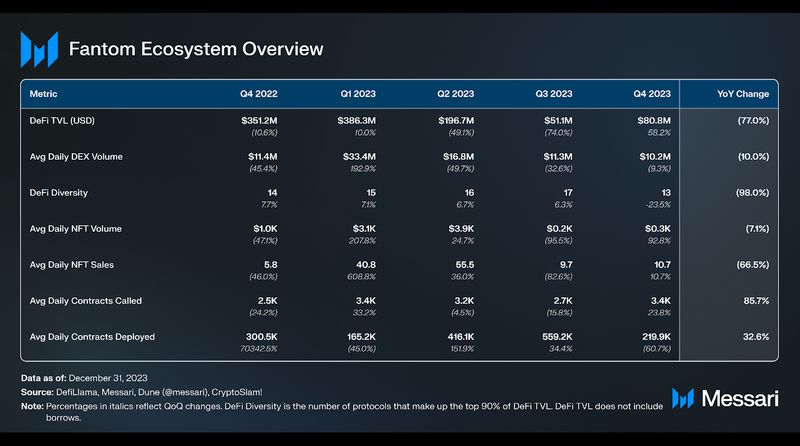
DeFi
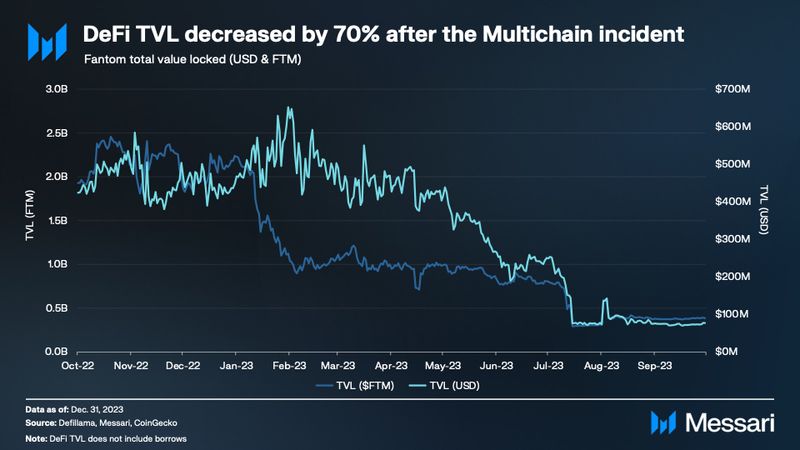
Fantom TVL denominated in USD increased from $51 million in Q3 to $81 million in Q4, up 58% QoQ. This ranked Fantom the 34th chain by TVL denominated in USD by the end of 2023. However, TVL denominated in FTM decreased QoQ by 29% from 261 million FTM to 185 million FTM. As such, part of the increase in TVL was likely determined by the asset price decreases in USD. Nonetheless, the increase in TVL during Q4 was a healthy sign after the hit the DeFi ecosystem took from the Multichain incident in Q3.
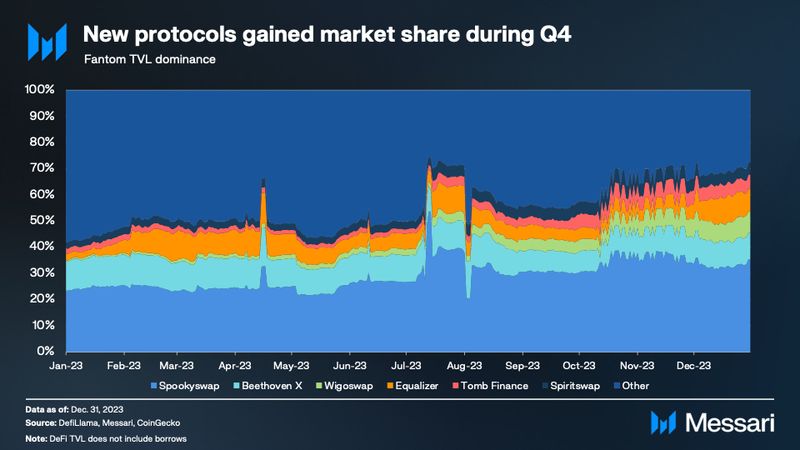
Q4 also saw a shake-up in the top DeFi applications on Fantom. New entrants into the top five included Equalizer Exchange, WigoSwap, and SpiritSwap with Tarot, Scream, and Stargate losing market share of TVL. Notable protocols by TVL include Spookyswap (+84%), Beethoven X (+107%), Equalizer Exchange (+206%),WigoSwap (+191%), and SpiritSwap (+59%). In total, these six protocols gained $29 million in TVL, which was nearly 100% of Fantom’s TVL gain for Q4.
By the end of the quarter, Equalizer and WigoSwap gained the most market share, increasing to 8.7% (+93%) and 8.2% (+84%). Furthermore, this market share came at the expense of lower TVL protocols. The market share of all protocols outside of the top 6 decreased QoQ by 36% from 43% to 27%. These changes in market share caused the first decrease in over a year in Fantom’s DeFi Diversity Score, which measures the number of protocols that make up the top 90% of TVL. By the end of Q4, 13 protocols made up the top 90% of TVL. Despite the decrease, Fantom’s DeFi Diversity Score remained similar to other Layer-1 networks.
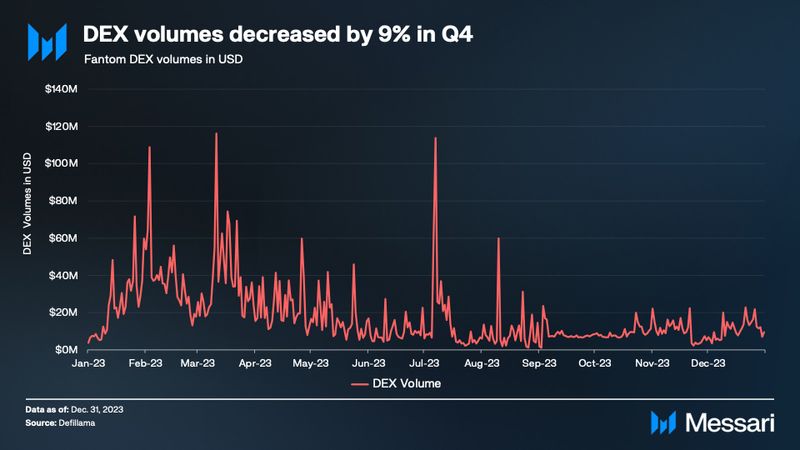
The average daily DEX volume on Fantom decreased by 10% QoQ to $10.2 million. DEX volumes experienced significant dropoffs coinciding with periods of increased activity for inscriptions during late November and early December. However, DEX volumes finished strong at the end of Q4, making December the highest activity month since July 2023. Notably, DEXs in the Fantom ecosystem have gotten considerably more competitive throughout 2023. In Q4’22, SpookySwap represented 57% of all DEX trading volumes on Fantom. But in December 2023, SpookSwap lost its #1 spot to WigoSwap, which did $106 million in volume. For Q4, the top three DEXs by trading volume were:
- WigoSwap – $163 million (17% of Fantom DEX volume)
- SpookySwap – $134 million (14% of Fantom DEX volume)
- Equalizer – $128 million (14% of Fantom DEX volume)
Stablecoins
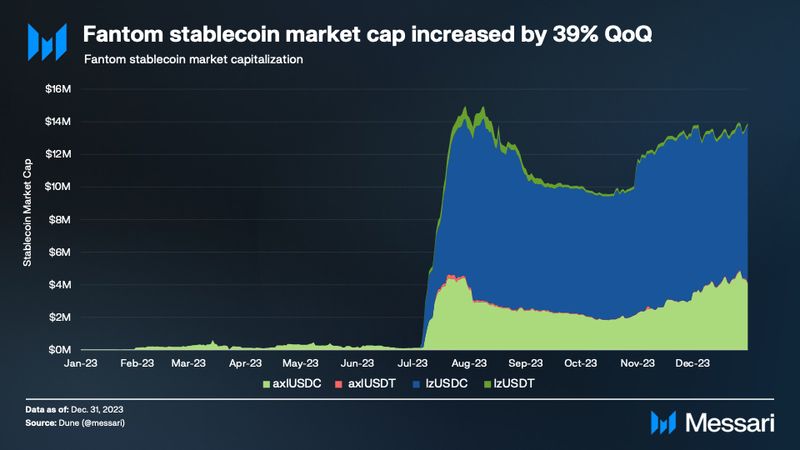
In July, Peckshield reported a potential exploit of the Multichain: Fantom Bridge, highlighting outbound transfers of 7,214 WETH (13.6 million), 1,023.8 WBTC (31 million), and 57.8 million USDC. The Multichain team confirmed that these were unauthorized transactions and advised all users to stop using Multichain services. In response to the Multichain incident, the Fantom Foundation stated the following in September:
An update on our work to identify affected assets within the Fantom community as a result of the July 6 Multichain exploit. Fantom Foundation has engaged leading blockchain intelligence firm, TRM Labs, to conduct an independent investigation and accelerate our ability to trace and recover funds for Fantom users. We continue to do everything we can to resolve this matter. We’d like to sincerely thank our community for their continued support.
Prior to the exploit, the vast majority of stablecoins on Fantom were bridged through Multichain. As such, once the exploit occurred, all stablecoins bridged through Multichain lost their backing. Prior to the exploit, the Fantom Foundation had taken steps to increase the liquidity of stablecoins on Fantom. Currently, there are primarily two independent third-party bridging solutions: Axelar (axlUSDC and axlUSDT) and LayerZero (lzUSDC and lzUSDT). It is important to note that as independent third parties deployed on Fantom, these two bridges are not actually managed by the Fantom Foundation.
By the end of Q4’23, the supply of these stablecoins grew 39% QoQ to 13.9 million from 10 million. Additionally, USDC is by far the most popular stablecoin on Fantom, representing nearly 99% of the stablecoin supply.
NFTs and Gaming
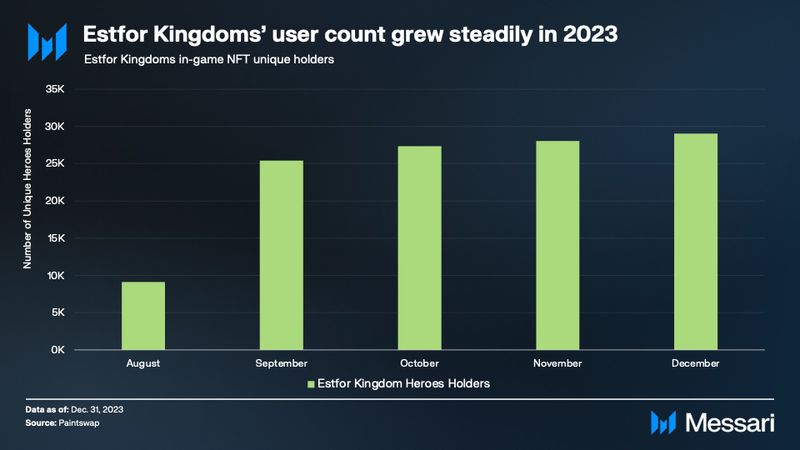
Estfor Kingdom is a multiplayer online role-playing game (MMORPG) launched during Q3’23 by the PaintSwap development team. Estfor Kingdom is browser-based and utilizes the Fantom blockchain for some of its in-game mechanics.
The medieval fantasy game is centered around in-game NFTs called Heroes. Each user can select one of the eight Hero characters and mint it for free. Each individual Hero archetype has unique properties that make it easier to level up certain skill sets. Furthermore, all in-game items are NFTs and can be traded in the Shop for the in-game currency, BRUSH.
During Q4’23, Estfor Kingdom built on its early success and continued increasing its player base. By the end of Q4, there were over 29,000 unique wallets with at least one Estfor Kingdom Hero NFT. Trading volumes for the in-game currency BRUSH reached their highest levels since Q2’23, reaching over $550,000 on December 1. Additionally, some in-game actions, such as purchases in the Shop, work by burning 25% of the BRUSH tokens associated with the transaction. Since launch, these burning mechanisms have burned over 197,000 BRUSH.
On October 13, Estfor Kingdom announced that it had received a long-term investment from the Fantom Foundation. This investment will secure its runway for 12+ months (from October), enabling the team to continue delivering unique gaming experiences on Estfor Kingdom.
Development
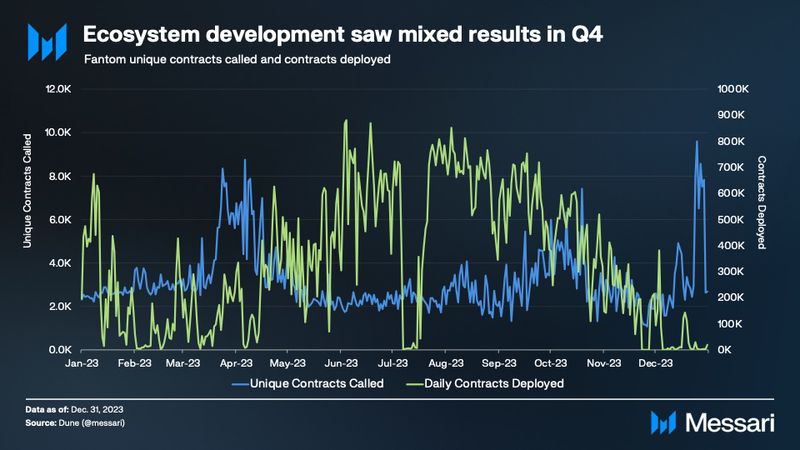
Ecosystem development, measured via the number of unique contracts called and new contracts, saw mixed results in Q4’23. The average for daily unique contracts called throughout the quarter increased by 24% to 3,400, but the average for daily deployed contracts decreased by 61% to 219,900. In preparation for Fantom Sonic’s 2024 release, Fantom started focusing on supporting developers looking to build on the new technology stack. On December 4, the Fantom Foundation announced the launch of Sonic Labs. Sonic Labs is an incubator program for developers building on Fantom Sonic. Currently, Sonic Labs is looking to fund up to five teams to build on Sonic with a total of 1 million FTM ($472,000 as of writing). In addition to funding, teams will also receive:
- Mentorship from Andre Cronje.
- Guidance from Pyth Network’s Marc Tillement.
- Compliance, payroll, and legal support.
- The opportunity to be included in the mainnet launch of Fantom Sonic.
Selected projects will receive support until August 2024 in addition to VC introductions and long-term planning. Interested teams and developers have until February 6, 2024, to apply. The selected projects will be announced on February 22, 2024.
Ecosystem Growth Strategy
Fantom has established several growth initiatives in the past year. Namely, Fantom’s Ecosystem Vault and Gas Monetization program both continued to support the ecosystem in Q4’23.The first of Fantom’s ecosystem initiatives for 2023 was its Gas Monetization program. This program aims to reward high-quality applications and offer a sustainable income for developers with a portion of the transaction fees they generate.

On July 19, 2023, the Fantom Foundation announced the introduction of a quarterly bonus for its Gas Monetization program. To qualify for the program, dApps need to have completed at least 125,000 transactions on Fantom and to have been live on Fantom for at least three months. Since not all dApps on Fantom can qualify for the Gas Monetization program, a portion of FTM from transaction fees accumulates to the program with no clear recipient. To distribute these FTM tokens, the Fantom Foundation decided to distribute them to the top 12 earning projects according to the following split:
- Ranks #1-3: 40% of the FTM
- Ranks #4-6: 30% of the FTM
- Ranks #7-9: 20% of the FTM
- Ranks #10-12: 10% of the FTM
In total, the quarterly bonus for Q4 was 314,000 FTM, down 38% from the Q3 bonus of 505,000 FTM. However, this drop was in part due to the Q3 bonus distributing FTM accumulated since the start of the Gas Monetization program. Further statistics related to the Gas Monetization program can be found here. Secondly, in Q4 2022, the Fantom Foundation launched an Ecosystem Vault on Fantom, which introduced a funding process to support ecosystem builders. With the initiative, one-third of the 30% transaction fee burn rate (at the time) would be redirected to a Special Fee Contract (SFC). On August 22, 2023, the Fantom Foundation announced that over 750,000 FTM tokens would be distributed in a Gitcoin funding round. Projects could apply from August 22-29, 2023, eligible recipients were announced on August 30, 2023, and on October 5, 2023, the Fantom Foundation announced the winners:
- Equalizer, PaintSwap/Estfor Kingdom, Mummy Finance, WigoSwap, and Beethoven X – 112,500 FTM
- DeFi Pool Share – 84,280 FTM
- FantomAdventureRPG – 48,302 FTM
- Fantom Lords – 40,000 FTM
- Debita – 14,920 FTM
The 750,000 FTM will be distributed to these projects over a six-month vesting period. After 25% is given upfront, the remaining 75% will be streamed over six months.
Closing Summary
Q4’23 was a strong quarter for Fantom. As life came back into the crypto markets, Fantom capitalized on this and outperformed the market on many of its metrics, such as market capitalization, daily average transactions, and DeFi TVL.
Looking forward to 2024, Fantom Sonic will likely play a key part in Fantom’s continued growth. Q4 saw important developments related to Sonic, such as the launch of the builders testnet. The builders testnet not only showcases the testnet but gives developers an environment to familiarize themselves with the capabilities associated with Sonic. In order to prepare the ecosystem for this upgrade, the Fantom Foundation launched Sonic Labs, an incubator program for developers building on Fantom Sonic. Currently, Sonic Labs is looking to fund up to five teams with a total of 1 million FTM ($472,000).
Despite some bumps along the way, 2023 showcased that Fantom will continue to build and grow despite the market conditions. In addition to the aforementioned Fantom Sonic upgrade, initiatives such as the Ecosystem Vault and Gas Monetization program laid the foundation for developers and users to remain committed to the network.













